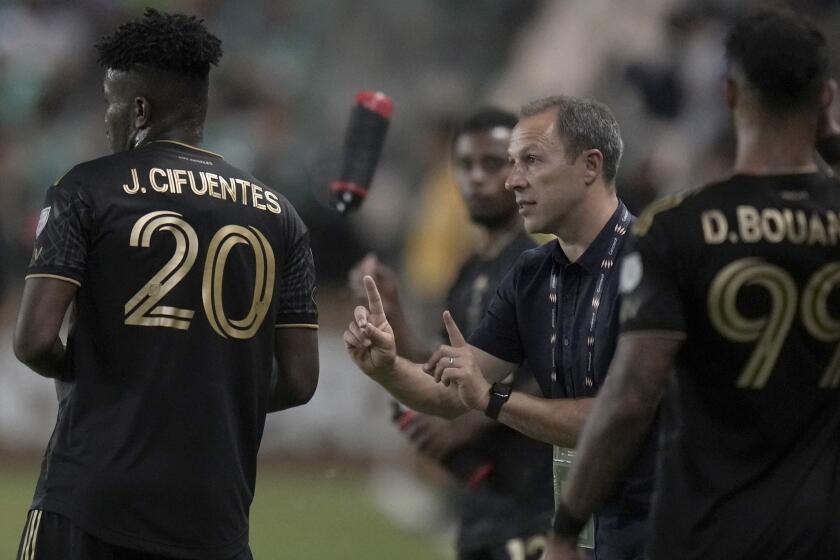New Kids Great for Granddaddy
- Share via
If you had any feel for history and the role of the underdog, you had to be rooting for Wisconsin to come to the Rose Bowl. Since the inception of the Rose Bowl’s pact with the Big Ten, there have been 47 games. In only three of them was Wisconsin one of the teams.
The Big Ten was more like the Big Two. Particularly in recent years. Michigan has come 13 times to Pasadena, Ohio State 11. In one stretch between 1969 and 1982, the visiting team was either Ohio State or Michigan every year. Ohio State came six times in eight years.
It got to be a little boring, to tell you the truth, especially when Woody Hayes no longer came with the Buckeyes.
Iowa managed to slip into four Rose bowls. So did Illinois and Michigan State. But Purdue came only once. Indiana made it only once. Northwestern, believe it or not, came in the prehistoric days of the pact. And won!
Of course, it’s hard to believe, but Harvard once came to the Rose Bowl. And won, too. So did Columbia.
When the Pac 10-Big Ten pact was signed, it had its critics. They thought it disenfranchised a lot of contenders, particularly in the old South. But in those benighted days, the old South played Jim Crow football. And the temper of the times was such that no West Coast team could play a Southern team in the segregated South--so why play them anywhere till they changed the rules? In those days, Jackie Robinson could play in a UCLA-Alabama game in the Coliseum or a Rose Bowl--but not in Birmingham.
The Pac 10-Big Ten lockup was an answer to a lot of headaches for the promoters. In those days, too, no Big Ten team could go to any other postseason bowl. Nor could a Coast team. This agreement unlocked that cage ultimately. In effect, it so legitimized bowl appearances that soon the floodgates opened and even Notre Dame started to go again.
There was the additional consideration that the Southern California of that time had largely been settled by Midwestern types. To the point where the joke about Long Beach was that its population growth was caused by “a slow leak in Des Moines.” Vice President Henry Wallace, getting off a train there once, hailed the crowd as “fellow Iowans!” It was really just a suburb of Keokuk.
The Rose Bowl officials did away with the messy, expensive, prolonged wooing of potential contenders. Nearly everyone wanted to come to the Rose Bowl, but there was always the concomitant question of who? Which team would make the best attraction on New Year’s Day? Notre Dame had come to one Rose Bowl, back in 1925, but, by the ‘40s, it considered going to a bowl game crass commercialism.
Crass commercialism has become considerably more socially acceptable in the interim, but when the Rose Bowl agreement with the Big Ten was being negotiated, the cupboard was considerably barer. The Ivy League had long since turned its nose in the air at (ugh!) bowl games. So had other institutions of higher learning that still considered their athletic programs adjuncts of the academic programs. Football players were expected to be students. Today, the academic requirement is to be able to run the 40 in 4.3 seconds or throw a football through a moving tire or kill a running squirrel with it at 50 paces.
But the Big Ten pact was signed in the days before the bowl coalition (which is really the poll coalition) and interlocking agreements between the bowl hosts seemed to be leading to a kind of football national finals.
UCLA-Wisconsin probably won’t prove anything in the grand scheme of coalition football. The eyes of the football Establishment will be on the Orange Bowl, where Nebraska and Florida State will thrash it out for the national title--or maybe the Sugar Bowl where West Virginia and Florida will play in the hopes that Florida State-Nebraska is a scoreless tie.
Should West Virginia be in the Rose Bowl? Florida State, maybe? Should the Rose Bowl be a replay of Florida State-Notre Dame?
Probably. If the citizens of New Orleans can get excited about a team from West Virginia playing a team from Florida, California could probably take to its heart a game between a team from South Bend, Ind., and one from Tallahassee, Fla.
You have to ask yourself, which would sell better on pay-per-view TV--Notre Dame-Florida State? Or UCLA-Wisconsin? The Orange Bowl regularly puts up with out-of-state teams, Oklahoma-Nebraska, for instance, Notre Dame-Colorado. And still fills the seats.
The Big Ten-Pac 10 agreement is no longer a marriage made in heaven. The modern West Coaster feels less and less identification with his Midwestern (or Eastern) roots.
None of this should dampen the enthusiasm for Wisconsin-UCLA. Wisconsin in the Rose Bowl is a cosmic happening, like Halley’s Comet. You should get in on it because you don’t know whether you’re going to live long enough to see it again. It’s not going to shake up the coalition poll, but, come to think of it, is Notre Dame-Texas A&M; in the Cotton such a big deal? I’d rather see Boston College.
The Rose Bowl might be the logical sight for the Ultimate Bowl each year. After all, it invented the bowl game. But, for now, we’ll settle for a visit from strangers. We’ll welcome Wisconsin, and pull for Purdue and Indiana--and Northwestern--to make it back. It has been a hugely successful rivalry and if it has to give way for college football’s heavyweight championship fight in the future--well, whose idea was it in the first place anyway?
More to Read
Go beyond the scoreboard
Get the latest on L.A.'s teams in the daily Sports Report newsletter.
You may occasionally receive promotional content from the Los Angeles Times.










